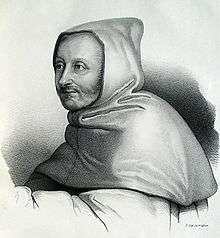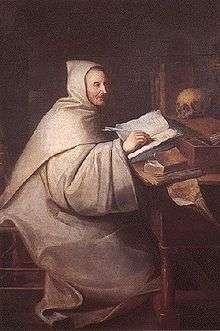Armand Jean le Bouthillier de Rancé
Armand Jean le Bouthillier de Rancé (9 January 1626, Paris – 27 October 1700, Soligny-la-Trappe) was an abbot of La Trappe Abbey and the founder of the Trappists.
Armand Jean le Bouthillier de Rancé | |
|---|---|
| Abbot of La Trappe Abbey | |
 Portrait of Armand Jean le Bouthillier de Rancé | |
| Appointed | 1636 (commendatory) 1664 (regular) |
| Orders | |
| Ordination | 1651 by Victor Le Bouthillier |
| Rank | Priest |
| Personal details | |
| Born | 9 January 1626 Paris |
| Died | 27 October 1700 (aged 74) Soligny-la-Trappe |
| Denomination | Catholic Church |
| Residence | La Trappe Abbey |
| Parents | Denis Bouthillier (father) |
| Occupation | Abbot |
| Profession | Trappist |
| Education | Doctor of Sacred Theology, 1654 |

Early life
Armand Jean le Bouthillier de Rancé was born 9 January 1626 in Paris, the second son of Denis Bouthillier, Lord of Rancé, and Councillor of State. His godfather was Cardinal Richelieu; his uncle Victor Le Bouthillier, Archbishop of Tours.[1]
Armand was originally intended for the Knights of Malta and regularly instructed in military exercises. The death of his older brother caused his father to dedicate him to ecclesiastical service, in order to preserve in the family the former numerous benefices. Hence when ten years old he was commendatory abbot of the Cistercian abbey of La Trappe and two other abbeys, prior of two priories, and canon of Notre-Dame de Paris, which gave him a revenue of about 15,000 livres. At twelve he published a translation of Anacreon with Greek notes. He attended the College d'Harcourt in Paris and went through his course of theological studies with great distinction.[2] In 1651, he was ordained priest by his uncle Victor Le Bouthillier and embarked on a career as a court abbot. The manner of life was worldly in the extreme.[1] He declined an appointment of bishop of the Diocese of St. Pol de Leon as he considered the income too small.[3]
In 1652 his father died, leaving him a further increase in estate. At the age of twenty-six he was thus left with practically unlimited wealth. He divided his time between preaching and other sacerdotal obligations, and feasting and the pleasures of fox hunting.[1] He obtained his Doctorate in Theology in 1654.[4] His uncle, who desired him as coadjutor, made him archdeacon, caused him to be elected deputy of the second order to the General Assembly of the French Clergy in 1655, and had him appointed First Almoner to Gaston, Duke of Orléans, in 1656.[3]
Monastic life and reform
The death of the Duchess of Montbazon, in 1657, gave him the first serious thought leading to his conversion. Later in 1660 he assisted at the death of the Duke of Orléans, which made so great an impression on him that he said: "Either the Gospel deceives us, or this is the house of a reprobate". After having taken counsel, he disposed of all his possessions, except the Abbey of La Trappe, which he visited for the first time in 1662.
He retired to his abbey, of which he became regular abbot in 1664 and introduced an austere reform.[2] Rancé's reform focused first and foremost centered on penitence. It prescribed hard manual labour, silence, a meagre diet, isolation from the world, and renunciation of most studies. The hard labour was in part a penitential exercise, in part a way of keeping the monastery self-supportive so that communication with the world might be kept at a minimum. This was also the reason why Rancé had Louis XIV's permission to remove the highway that ran outside the monastic walls.[5] Rancé devoted the little spare time he had to writing spiritual works. Amongst the most important are: Vies de plusieurs solitaires de La Trappe; Le traité de la sainteté et des devoirs de la vie monastique; La règle de s. Benoît, traduite et expliqué selon son véritable esprit, etc. An important episode of his subsequent life was the "Contestation" with Jean Mabillon on the lawfulness of monks devoting themselves to study, which De Rancé denied.
His penitential mode of life made him many enemies, and caused him to be accused of Jansenism, but he refrained from defending himself, until finally, at the request of his most intimate friends, he wrote to the Maréchal de Bellefonds, stating that he had signed the Formula (against Jansenism) without restriction or reservation of any kind; adding that he had always submitted himself absolutely to those whom God had placed over him, i.e., the pope and his bishop.
He resigned his abbacy in 1695, owing to declining health, and died in 1700.
Legacy
The practices that de Rancé instituted in La Trappe later spread to many other Cistercian monasteries which took up de Rancé's reforms. In time, these monasteries also spread and created new foundations of their own. These monasteries called themselves "Trappist" in reference to La Trappe, the source and origin of their reforms. In 1892, with the approval of Pope Leo XIII, the various Trappist congregations left the Cistercian Order and formed the Trappist Order, then named the 'Order of Reformed Cistercians of Our Lady of La Trappe'.[6]
A biography of his life, Vie de Rancé, was the final work of the Romantic writer and politician, François-René de Chateaubriand, published in 1844.
Bibliography
Works by de Rancé
- Vies de plusieurs solitaires de La Trappe
- Le traité de la sainteté et des devoirs de la vie monastique
- La règle de s. Benoît, traduite et expliqué selon son véritable esprit
Works about de Rancé
- Vie de Rancé
References
- Obrecht, Edmond. "Jean-Armand le Bouthillier de Rancé." The Catholic Encyclopedia Vol. 12. New York: Robert Appleton Company, 1911. 24 June 2019

- Chisholm 1911.
- Butler, Charles. The Lives of Dom Armand-Jean Le Bouthillier de Rancé, London. Luke Hansard & Sons. 1814, p. 10

- Weitlauff, Manfred, "Rancé, Armand-Jean Le Bouthillier de", Religion Past and Present. 2011ISBN 9789004146662
- Mette B. Bruun, "A Case in which a Revitalization of Something Medieval Turned out not to be Medievalism," in: Falling into Medievalism, ed. Anne Lair and Richard Utz. Special Issue of UNIversitas: The University of Northern Iowa Journal of Research, Scholarship, and Creative Activity, 2.1 (2006) Archived 2011-07-20 at the Wayback Machine.
- OCist.Hu - A Ciszterci Rend Zirci Apátsága (31 December 2002). "History". OCist.Hu. Retrieved 9 March 2011.


External links
| Wikimedia Commons has media related to Armand Jean le Bouthillier de Rancé. |
- Works by or about Armand Jean le Bouthillier de Rancé in libraries (WorldCat catalog)